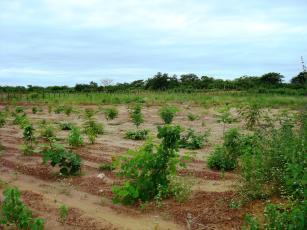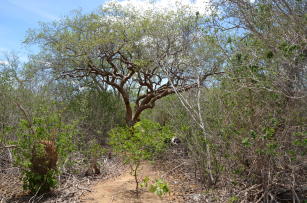Science recovers soils in Brazilian Northeastern oil areas
Science recovers soils in Brazilian Northeastern oil areas
Photo: Alexander Resende

Areas previously used for oil exploration have recovered their original vegetation
Researchers have developed a methodology that makes the fast growth of tree and bush species possible in soils where oil production and natural gas activities have previously occurred. It is based on a technology that has already been consolidated for over two decades for the rehabilitation of areas degraded by mining, and which has been applied in the country's Southeast and North. The work of recovery has been validated and is backed by over a decade of studies. The scientists now intend to train technicians to work in the recovery of degraded areas so that they resume the native vegetation or are turned to croplands or pastures.
The study, in the regions of the Assu Valley, Mossoró and Macau, in Rio Grande do Norte state (RN), is the result of a partnership between Embrapa and Petrobras, and also counts on the participation of the Federal Rural University of the Semi-arid Region (Ufersa). "Twelve years after the first sowing, it is already possible to see native Caatinga animal and plants present, in fact overcoming one of the longest drought periods in the region, between 2012 and 2017", testifies Alexander Resende, a researcher from Embrapa Agrobiology (Seropédica, RJ).
After minerals are extracted, the soils become very rocky, with low organic matter content, in a biome where rainfall is lower than 600 mm a year. This type of environment, created by the mining of shale clay, is a new one, created by man and nonexistent in the native Caatinga. Hence it was necessary to find species capable of adapting to such ecosystem. The technique developed by Embrapa mainly uses species from the Leguminosae family that, once inoculated with bacteria and fungi, acquire greater resistance and grow in soils that have been impacted by oil production activities.

Drones monitor recovery
The researchers from Embrapa and Petrobras introduced new tools for the monitoring of revegetated areas, such as the use of drones to take pictures and assess how the plants are growing and occupying the soil. "The goal in this in case is to see the speed with which the plants cover the soil and the rate of variation between drought and rain periods", the Embrapa researcher Alexander Resende exposes.
The researchers want to assess the development and the survival of the species introduced in the first years of the study, see the effect of such plants in the natural recruitment of new species and in the recovery of the substratum of the degraded environments. "Having the chance to keep assessing experiments of over ten years of age in this biome which is still understudied is a landmark for research in Brazil", analyzes Frederico Machado, an environmental engineer from Petrobrás' Research Center, Cenpes.
Photo: Magda Cruciol
There are 191 hectares in the process of recovery and about 200,000 seedlings planted. According to the researchers, several species and kinds of plantation have been tested. Mimosa tenuiflora, Mimosa verrucosa and Mimosa caesalpiniifolia (known as jurema-preta, jurema-branca and sabiá in Portuguese) are examples of some plants that have adapted well. They are fertilized with manure and, when possible, planted in areas where surface soil from new oil wells was added.
Focus on planting and on water retention
Making planting viable in dry periods, as well as the assessment of methods that increase water retention into the soils, were premises of the partnership. To skirt water stress, Embrapa researchers used strategies to conserve soil humidity post-plantation, such as adding wax palm straw, the use of seedlings with prolonged roots and of soil moisture conditioners such as manure and hidrogel. "We already have plants such as 'orelha-de-macaco' and 'jurema' [Enterolobium contortisiliquum and Mimosa tenuiflora] that have grown more than three meters high in less than two years, which is an excellent result for the conditions in which we are working", celebrates the Embrapa researcher Guilherme Chaer.
Technology on displayThis technology of area recovery will be presented at the 6th Northeastern Forest Engineering Congress (Coneflor), which will be held in the second week of May, in Mossoró, RN. On May 10, event participants will be able to see the technology showcase elaborated by researchers from Embrapa and Petrobrás first-hand. The venue will be a space for the exchange of experiences on environmental recovery in the Caatinga. |
Rehabilitating such type of soil is complex and can be rather cumbersome, given the severity of changes to the ecosystem. Frederico Machado explains that the initial target was to reduce the time needed and the costs of recovering such areas in the Brazilian Northeast. But the partnership between researchers from the two state companies has worked out so well that the result can be extended to other regions. "Despite the specificities of the biome, it is believed that some techniques could be used in other operational units of the company", Machado discloses..
Ecological restoration with economic returns
Most of these areas are leased and need to be returned to the owners in good condition for the development of production activities or to recompose the property's conservation reserve as defined by law. Erik Petric, an environmental analyst from Petrobras' Operational Unit in Rio Grande do Norte and Ceará, explains that the environmental recovery activities are defined in accordance with the guidelines established by environmental agencies and the use that landowners intend to give their lands when they are returned. Petric has been overseeing the research in Rio Grande do Norte for 12 years. "With this technique, the recovery of the areas has been a success", the analyst punctuated.
Despite having already proven the results of the technique, the researchers now want to increase the number of species and implement new plantation alternatives that conciliate ecological restoration with economic returns. "We have been assessing the adaptation of about 30 species, some of which are very emblematic of the Brazilian Semiarid region, like mandacaru (Cereus jamacaru), carnauba wax palm and catanduva (Pityrocarpa moniliformis), or fruit trees such as cashew and hog plum, and others with timber potential, like sabiá and urunday", Chaer details.
In the area used by the study, the scientists intend to create a technology showcase for the training of techinicians and farmers. "We want to demonstrate that it is possible to give an economic use to the areas in the process of recovery", Chaer informs. The idea is to use revegetation techniques to restore the environment in the Caatinga biome and also introduce sustainable production systems like, for example, silvopastoral and agroforestry ones.

Different areas to be recovered
Shale clay extraction deposits:
in these areas, the entire surface layer of the soil, which is rich in nutrients, organic matter, seeds and fauna was removed to obtain shale clay, a material that is used in the foundations for civil and oil engineering construction sites and is similar to gravel.
In a scenario of extreme changes to the ecosystem, the researchers needed to proceed to organizing the landscape, directing the water proceeding from rains to specific points, in order to concentrate it and create large water reservoirs where animals can quench their thirst, for instance. "In a Semiarid environment, this technique is extremely valued by landowners", explains the researcher Alexander Resende.
This stage is followed by rectifying slopes, improving their stabilization, and then planting species that can withstand extreme degradation. The shale clay removed is used to make the foundation for access areas and new allocations of inland oil wells.
Onshore oil well bases: when there is potential for oil in a specific location, areas are cleared and the surface soil (which will be used for the recovery of formerly degraded areas) is removed. To these places, in order to allow the perforation drill to work, shale clay is added, which once compacted, allows the drill to enter the new oil well. This material is also used in roads to access such wells. After oil production ends, this area also is revegetated.
Photo: Alexander Resende
Translation: Mariana Medeiros
Ana Lucia Ferreira (MTb 16913/RJ)
Embrapa Agrobiology
Press inquiries
agrobiologia.imprensa@embrapa.br
Phone number: +55 21 3441-1596
Further information on the topic
Citizen Attention Service (SAC)
www.embrapa.br/contact-us/sac/






